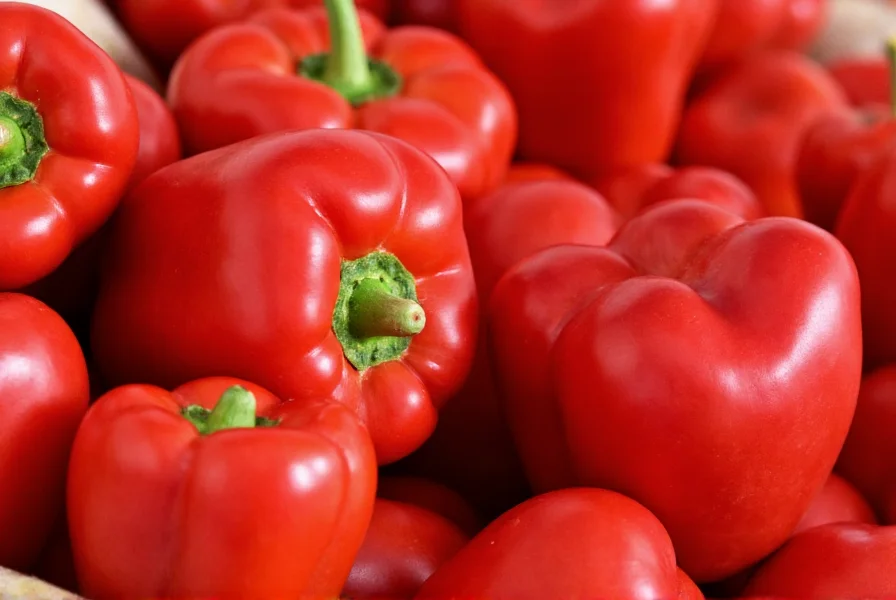A medium raw red bell pepper (approximately 119 grams) contains 37 calories. This vibrant vegetable offers substantial nutritional benefits with minimal caloric impact, making it an excellent choice for health-conscious diets.
Understanding the nutritional profile of red peppers helps clarify why they're a staple in balanced eating plans. Unlike many low-calorie foods that sacrifice nutrient density, red bell peppers deliver exceptional value per bite. Their sweet flavor and crisp texture make them versatile across cuisines while supporting various dietary goals.
Nutritional Breakdown of Red Bell Peppers
Red bell peppers represent the mature version of green bell peppers, developing higher nutrient concentrations as they ripen. This maturation process significantly boosts their vitamin content while maintaining a remarkably low-calorie profile.
| Nutrient | Per 100g | Medium Pepper (119g) | Percent Daily Value* |
|---|---|---|---|
| Calories | 31 kcal | 37 kcal | 2% |
| Total Carbohydrate | 6.0 g | 7.1 g | 2% |
| Dietary Fiber | 2.1 g | 2.5 g | 9% |
| Vitamin C | 127 mg | 152 mg | 169% |
| Vitamin A | 3131 IU | 3726 IU | 75% |
| Vitamin B6 | 0.3 mg | 0.35 mg | 18% |
*Percent Daily Values based on a 2,000 calorie diet
Comparing Pepper Varieties: Calorie and Nutrient Differences
While all bell peppers share similar caloric content, their nutritional profiles vary significantly based on color and ripeness. Red bell peppers contain nearly 1.5 times more vitamin C than green peppers and substantially higher levels of beta-carotene, which converts to vitamin A in the body.
| Pepper Type | Calories (Medium) | Vitamin C | Vitamin A | Antioxidant Level |
|---|---|---|---|---|
| Red Bell Pepper | 37 | 152 mg | 3726 IU | ★★★★★ |
| Yellow Bell Pepper | 32 | 132 mg | 3100 IU | ★★★★☆ |
| Orange Bell Pepper | 34 | 140 mg | 3400 IU | ★★★★★ |
| Green Bell Pepper | 24 | 95 mg | 833 IU | ★★★☆☆ |
The extended time red peppers spend ripening on the plant explains their superior nutritional profile. As peppers mature from green to red, their sugar content increases slightly (adding minimal calories) while antioxidant compounds develop substantially.

Health Benefits Beyond Calories
Red bell peppers offer remarkable health advantages that extend far beyond their low-calorie count. Their exceptional vitamin C content supports immune function and collagen production, while the high vitamin A content promotes healthy vision and skin.
The carotenoids in red peppers, particularly lycopene and beta-carotene, function as powerful antioxidants that combat oxidative stress. Research indicates these compounds may reduce inflammation and lower the risk of chronic diseases. Unlike supplements, these nutrients in whole food form work synergistically with other compounds naturally present in peppers.
For those managing blood sugar levels, red peppers present an excellent option. With a glycemic load of just 2, they provide substantial volume and nutrients without significantly impacting blood glucose. The dietary fiber content further supports digestive health and promotes satiety.
Practical Applications in Meal Planning
Incorporating red peppers into your diet requires minimal effort but delivers maximum nutritional payoff. One medium red bell pepper counts as a full vegetable serving in most dietary guidelines. Their versatility allows for numerous preparation methods without compromising nutritional value.
Raw red peppers preserve maximum vitamin C content, making them ideal for salads and crudités. When cooking, quick methods like stir-frying or roasting maintain most nutrients while enhancing flavor. The vitamin A compounds in red peppers are fat-soluble, so pairing them with healthy fats like olive oil improves absorption.
For meal preppers, properly stored red peppers maintain freshness for 1-2 weeks in the refrigerator. Remove stems and seeds, slice into strips, and store in an airtight container with a paper towel to absorb excess moisture. This preparation makes them ready for quick additions to omelets, grain bowls, or wraps throughout the week.

Addressing Common Misconceptions
Some believe that the slightly higher sugar content in red peppers compared to green varieties significantly increases calories. In reality, the difference amounts to just 1-2 grams of sugar per pepper, adding approximately 4-8 calories. This minimal increase brings substantial nutritional benefits without compromising the vegetable's status as a low-calorie food.
Another misconception suggests cooking destroys all nutritional value in peppers. While vitamin C degrades with heat, other beneficial compounds like carotenoids become more bioavailable through cooking. The key is using appropriate cooking methods that balance nutrient preservation with enhanced absorption of fat-soluble vitamins.
Conclusion
Red bell peppers represent an exceptional nutritional bargain—delivering abundant vitamins, antioxidants, and fiber for minimal calories. With approximately 37 calories per medium pepper, they provide more than 100% of your daily vitamin C needs while contributing to overall dietary quality. Whether enjoyed raw in salads, roasted for depth of flavor, or incorporated into cooked dishes, red peppers offer versatile culinary applications without compromising health goals. Their superior nutrient profile compared to less mature pepper varieties makes them a worthwhile addition to any balanced eating pattern.
Frequently Asked Questions
How many calories are in a cup of chopped red bell pepper?
One cup (approximately 150 grams) of chopped raw red bell pepper contains about 46 calories. This serving provides substantial dietary fiber and meets more than 150% of the daily recommended intake for vitamin C.
Are red peppers good for weight loss?
Yes, red peppers support weight management efforts. With only 37 calories per medium pepper and high water and fiber content, they add volume to meals without significant caloric impact. The capsaicinoids in peppers may also modestly boost metabolism, though red bell peppers contain much less than hot pepper varieties.
Do cooked red peppers have the same calorie count as raw?
Yes, cooking doesn't significantly change the calorie content of red peppers. One medium roasted red pepper still contains approximately 37 calories. However, cooking methods that add oil or other ingredients will increase the total calories. Water-based cooking methods like steaming preserve the original calorie count while enhancing certain nutrient absorptions.
How do red pepper calories compare to other common vegetables?
Red bell peppers have slightly more calories than some vegetables like cucumbers (16 calories per cup) but fewer than starchy vegetables like corn (132 calories per cup). Compared to other non-starchy vegetables, they're similar to broccoli (55 calories per cup) and carrots (52 calories per cup), but offer superior vitamin C content. Their calorie-to-nutrient ratio makes them exceptionally valuable.
Can I eat red peppers on a low-carb diet?
Absolutely. One medium red bell pepper contains approximately 7 grams of total carbohydrates, with 2.5 grams coming from fiber, resulting in just 4.5 net carbs. This makes them suitable for most low-carb and ketogenic eating plans when consumed in reasonable portions. Their high nutrient density provides significant nutritional value within carbohydrate restrictions.











 浙公网安备
33010002000092号
浙公网安备
33010002000092号 浙B2-20120091-4
浙B2-20120091-4